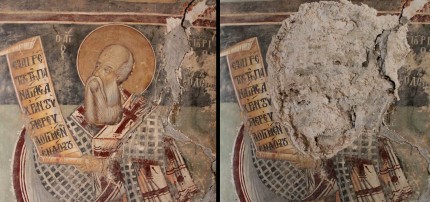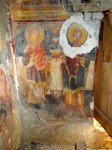 Frescoes in the 16th-century Orthodox church of St. Friday’s in Valsh, a remote Albanian village 35 miles south of Tirana, have been damaged beyond repair by looters. Twice in a week, the first time on December 30th, the second on January 4th, thieves hacked at the frescoes with axes and knives, focusing mainly on removing the heads of saints.
Frescoes in the 16th-century Orthodox church of St. Friday’s in Valsh, a remote Albanian village 35 miles south of Tirana, have been damaged beyond repair by looters. Twice in a week, the first time on December 30th, the second on January 4th, thieves hacked at the frescoes with axes and knives, focusing mainly on removing the heads of saints.
To add insult to injury, the looters were incompetent. Most of the seven or eight frescoes (the number is different in different reports) attacked wound up crushed in pieces on the floor instead of removed whole. Some of the worst damage was done to the fresco of St. Friday’s. His entire head and the aureole around it is gone, as is the inscription to the left of the halo which was important for art historical reference.

The frescoes are by master icon painter Onufri who lived in Valsh and frescoed the walls of its modest little church in 1554. Known for his use of brilliant colors and his introduction of more realistic facial expressions into the flat conventions of Byzantine style, Onufri is considered Albania’s greatest icon maker, although it’s not certain if he was born in what is today Albania or in northern Greece. The signature on his Valsh frescoes — Protopapas — indicates he held a position of importance in the Greek Orthodox church.
 The first bout of destruction was discovered by the villagers who notified the police, local heritage officials and the Orthodox Church immediately. The locks were changed but nothing else was done to protect the church, and the thieves just waltzed right back in five days later and hacked at the walls some more. The ease with which this offense was perpetrated has led some heritage advocates to suspect that the police may have been involved, or at least paid off.
The first bout of destruction was discovered by the villagers who notified the police, local heritage officials and the Orthodox Church immediately. The locks were changed but nothing else was done to protect the church, and the thieves just waltzed right back in five days later and hacked at the walls some more. The ease with which this offense was perpetrated has led some heritage advocates to suspect that the police may have been involved, or at least paid off.
Albania is a very bad space right now when it comes to heritage protection. Since the fall of the communist regime in 1991, more the 2,000 icons have been stolen from churches and museums. In the past two years alone, 20 Orthodox churches and monasteries have been targeted by looters. In 2007, the Ministry of Culture eliminated the custodian system which, while fairly weak, at least ensured that sites of cultural and historical importance were guarded by a living breathing human being. It was cheap, too. The guards were paid €30 ($40) a month, for a total yearly cost to the government of just €40,000 ($54,000).
I don’t care how broke they are, there is no way that this program had to be eliminated purely to save costs. In fact, after years of protests from Orthodox officials and heritage advocates, in 2011 the government budgeted €200,000 ($266,000) for cultural heritage protection. This did not assuage the people concerned about the decimation of Albania’s history, because it’s a ludicrously paltry sum.
The Ministry of Culture is irritatingly fatalistic about this ongoing disaster. Head of the heritage department Olsi Lafe said at a press conference last week that they are working with the police on the thefts at Valsh, but there isn’t much they can do on the larger problem. They have too much territory, much of it rural, to cover effectively.
“Considering the large number of religious heritage monuments, it’s impossible to protect them 24-hours a day,” the ministry said. “It would require a large number of people and a special administrative structure,” it added.
Yes it’s amazing how significant programs require manpower and funding. Shocking news there.
Oh God no ……
I know… 🙁
I would wager that if that was a historical mosque in Albania, they wouldn’t want to sweep it under the rug…… This is like the Buddahs that the Taliban blew up. Such beautiful art, gone…. I hope they at least have reasonable photos of the frescoes somewhere.
The frescoes have been studied extensively by art historians so there are pictures. The religious and ethnic dynamics are definitely present. The country is majority Muslim, but a significant minority of around 17% is Christian. One Orthodox church functionary I read about thinks the motive for the destruction was not profit but religious vandalism. He believes the government is covering it up or looking the other way because it’s Orthodox art being destroyed.
Another blogger I read posited that it’s all about ethnic Greeks vs. ethnic Albanians. According to him, Valsh is populated by ethnic Greeks whom the authorities treat them like second class citizens.
That was the point of my comment. 🙂 That because it is just “old” and “christian” and “greek” they are doing the whole “who cares” bit. If someone pried the tiles off of a mosque they would be madder than a wet hen. I would bet that every penny of the $266 grand goes to protect muslim heritage sites only.
Do you know if there an online location to find those photos? Thanks
This kind of destruction breaks my heart. It does look like vandalism rather than stealing to me. It’s easy enough to hack a whole wall out and more valuable too. Bunch of animals in this town! :angry:
Agreed, and it is all of humanity and not just the Albanians that loses when this sort of thing happens. I mean history everywhere affects everyone, it is there to learn from.
This is indeed a tragedy, but as the pictures make clear is a botched attempt to remove the frescoes for sale. Turning this into a Muslims vs Christians Balkan nightmare, as some above seem to want to do, is really not helpful. Albania is a haven of general sanity in this regard and Christian and Islamic monuments get the same degree of State protection, which sadly is not saying a lot. There are plenty of neglected historic mosques, as there are abandoned and neglected churches and monasteries.
It must be said though that the potential of Albania’s extraordinary cultural heritage tends not to be understood at a political level. Rather than a significant adjunct the country’s economy to be exploited properly in a sustainable fashion, it is very much the Cinderella of the state. Odd for a country with such a strong sense of its historic identity. The ministry of Culture in particular is used as a reward and sinecure for a sequence of ever-changing ministers who do little to engage its structure with other agencies.
The way to prevent this form of destruction occurring is to really try to engage local communities with their heritage, give them a stake, let them see tangible benefits from visitors and tourism, reinvest the money in their local areas rather than siphoning it off to Tirana. Sadly this happens but rarely. Butrint, the great archaeological and natural site in the far south has in theory an autonomous existence, and 90% of its revenues are to be reinvested. Despite a positive and energetic director we wait to see whether this will really occur. In any case, come the next general election all such posts will be reassigned on a political basis and figures of undoubted ability may find themselves watching the less able filling their old shoes.
It’s not all doom and gloom though, there are some remarkable success stories. The generally good condition of the great Ottoman town of Berat with its painted churches (more Onufri and his son Nikola) and mosques, sustained by an active and positive atelier of historic monuments. Even the saving of Gjirokastra, another magnificent Ottoman city, despite the loss of a number of its great early 19th century mansions, is cause to celebrate. Much has been lost, but much remains. Butrint has already been mentioned, Antigoneia, the city of King Pyrrhus, Byllis an Illyrian mountaintop city and so on.
Albania is typical of a developing country, with very limited resources to spend on cultural heritage and in the dire economic atmosphere (which has lost the country a massive chunk of income from subventions from emigrants working abroad) and yet the paradox is that this form of cultural heritage is a source of relatively easily available pump priming for other activities and needs. Regrettably the hot-house nature of Albanian politics (‘the passions run so high as the stakes are so low’ in all senses) such things are secondary to ‘clientilismo’ and personal position.
very irresponsible comment. in Valsh region of Shpat never has been any greek speaking population. do not create something that never egzisted
While I heartily agree, nationalist nonsense is really unacceptable, the frescoes themselves demonstrate that some people must have spoken Greek! However, having Greek (or any other language speakers) in an area does not actually denote ethnicity or ownership by any particular group.
People here who ignore that this is quintessential muslim vandalism are not very well informed. This and MUCH WORSE desecration has been happening in Kosovo for over a decade where HUNDREDS of Orthodox churches – some dating back to the 800s have been desecrated including cemeteries. Manny have been burned to the ground. It is abhorrent. Meanwhile United Nations troops stationed there have done nothing to stop it, let alone the albanian authorities.
The way the faces were targeted clearly indicates an attempt to loot for profit. Wanton destruction is not so specific. The sad truth is that looting knows no country, race or creed. The only requirement is a thirst for quick money and unscrupulousness.
Thank you and I appreciate your comment.